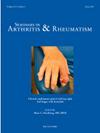The Fifth Element: Is Vascular Dysfunction an Intrinsic Feature of Gout?
IF 4.6
2区 医学
Q1 RHEUMATOLOGY
引用次数: 0
Abstract
Gout, the most common inflammatory arthritis, affects as many as 5.1% of the adult population. Classically, gout is conceived as four sequential phenotypic states: 1) asymptomatic hyperuricemia 2) acute gout flare 3) inter-critical gout (gout between flares); and 4) tophaceous gout. However, these four states are paralleled by a fifth state, consisting of vascular involvement. The mechanisms and consequences of vascular gout are incompletely elucidated. In vitro and animal models indicate that soluble urate adversely affects vascular endothelium and smooth muscle. The recent discovery that soluble urate can be transported intracellularly to alter cell metabolism and epigenetics (trained innate immunity) suggests additional impacts of urate on leukocytes and endothelium. Once gout has progressed to flares, the vasculature is exposed to inflammatory mediators, both during flares and to a lesser but persistent extent inter-critically, suggesting additional mechanisms of gout's effect. We have reported that patients with gout have diminished endothelial function measured by brachial artery flow-mediated dilation. ACR gout guideline-concordant treatment improves endothelial function but is less effective in patients with cardiometabolic comorbidities. Moreover, treatment of gout patients with the anti-inflammatory colchicine and urate lowering therapy improves endothelial function and reduces the risk of both incident coronary artery disease (CAD), and MACE in patients with established CAD.
第五要素:血管功能障碍是痛风的内在特征吗?
痛风是最常见的炎症性关节炎,影响多达5.1%的成年人。传统上,痛风被认为是四种顺序的表型状态:1)无症状高尿酸血症2)急性痛风发作3)临界间痛风(发作间痛风);4)痛风。然而,这四种状态与第五种状态平行,包括血管受累。血管性痛风的机制和后果尚未完全阐明。体外和动物模型表明可溶性尿酸对血管内皮和平滑肌有不利影响。最近发现,可溶性尿酸盐可以在细胞内转运,从而改变细胞代谢和表观遗传学(后天免疫),这表明尿酸盐对白细胞和内皮细胞有额外的影响。一旦痛风发展为急性发作,血管暴露于炎症介质,无论是在急性发作期间,还是在较小但持续的程度上,这表明痛风的作用还有其他机制。我们曾报道过,痛风患者通过肱动脉血流介导的扩张测量内皮功能减弱。与ACR痛风指南一致的治疗可改善内皮功能,但对有心脏代谢合并症的患者效果较差。此外,抗炎秋水仙碱和降尿酸疗法治疗痛风患者可改善内皮功能,降低冠心病患者发生冠心病(CAD)和MACE的风险。
本文章由计算机程序翻译,如有差异,请以英文原文为准。
求助全文
约1分钟内获得全文
求助全文
来源期刊
CiteScore
9.20
自引率
4.00%
发文量
176
审稿时长
46 days
期刊介绍:
Seminars in Arthritis and Rheumatism provides access to the highest-quality clinical, therapeutic and translational research about arthritis, rheumatology and musculoskeletal disorders that affect the joints and connective tissue. Each bimonthly issue includes articles giving you the latest diagnostic criteria, consensus statements, systematic reviews and meta-analyses as well as clinical and translational research studies. Read this journal for the latest groundbreaking research and to gain insights from scientists and clinicians on the management and treatment of musculoskeletal and autoimmune rheumatologic diseases. The journal is of interest to rheumatologists, orthopedic surgeons, internal medicine physicians, immunologists and specialists in bone and mineral metabolism.

 求助内容:
求助内容: 应助结果提醒方式:
应助结果提醒方式:


